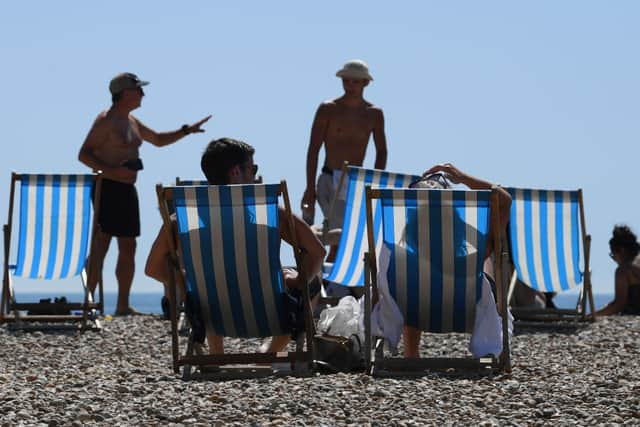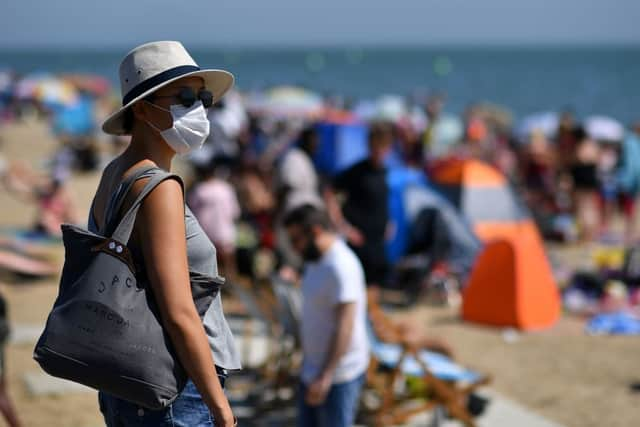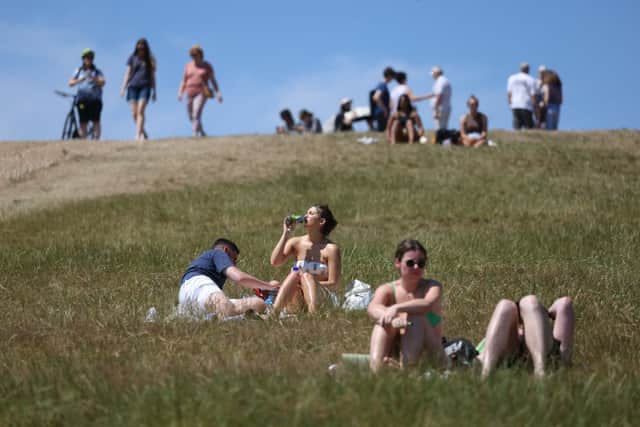What is a Level 3 heat alert? Level 1, 2, 3 and 4 explained as new warning issued - and NHS advice
and live on Freeview channel 276
The Heat-Health Alert Service has issued a Level 3 heat alert across England as temperatures climb across the country.
The Heat-Health Alert Service is a service which is provided by the UK Health Security Agency (UKHSA) from June to September and is aimed at the health sector. It covers England only.
Advertisement
Hide AdAdvertisement
Hide AdDifferent alert levels are issued depending how high the probability is of regions reaching their respective Heat-Health thresholds.
The threshold temperatures are:
- North East England: day max 28°C, night min 15°C
- North West England: day max 30°C, night min 15°C
- Yorkshire and the Humber: day max 29°C, night min 15°C
- West Midlands: day max 30°C, night min 15°C
- East Midlands: day max 30°C, night min 15°C
- East of England: day max 30°C, night min 15°C
- Southeast England: day max 31°C, night min 16°C
- London: day max 32°C, night min 18°C
- Southwest England: day max 30°C, night min 15°C
What are the alert levels?
There are four levels in total - this is how the Met office breaks up the different alert levels:
Level 1
Level 1, also known as the green alert level, is the minimum state of vigilance during the summer.


During this time social and healthcare services will ensure that all awareness and background preparedness work is ongoing.
Level 2
Advertisement
Hide AdAdvertisement
Hide AdLevel 2, also known as the yellow alert level, is triggered as soon as the risk is 60% or above for threshold temperatures being reached in one or more regions on at least two consecutive days and the intervening night.
The Met Office says that this “is an important stage for social and healthcare services who will be working to ensure readiness and swift action to reduce harm from a potential heatwave”.
Level 3
Level 3, also known as an amber alert, is triggered when the Met Office confirms that the threshold temperatures for one or more regions have been reached for one day and the following night, and that the forecast for the next day has a greater than 90% confidence level that the day threshold temperature will be met.
Level 4
Level 4 is a red alert and the highest alert possible. It is listed as a “national emergency” by the Met Office.


Advertisement
Hide AdAdvertisement
Hide AdA Level 4 alert is reached when a heatwave is so severe and/or prolonged that its effects extend outside the health and social care system. At this level, illness and death can occur among the fit and healthy, not just in high risk groups.
What warnings are in place?
As it stands, these are the alerts that have been put in place:
- Southwest England - Level 3 (amber)
- Southeast England - Level 3 (amber)
- London - Level 3 (amber)
- East of England - Level 3 (amber)
- East Midlands - Level 3 (amber)
- West Midlands - Level 3 (amber)
- North West England - Level 3 (amber)
- Yorkshire and the Humber - Level 3 (amber)
- North East England - Level 3 (amber)
What has the Heat-Health Alert Service said?
In a warning released on the Met Office website, the Heat-Health Alert Service warned that there is a 90% probability of the Heat-Health Alert criteria being met England.
It said that “is a 90 % probability of Heat-Health Alert criteria being met between 1200 on Tuesday 09 Aug and 2100359 on Sunday 14 Aug in parts of England”.


Advertisement
Hide AdAdvertisement
Hide AdIt added: “The biggest uncertainty is over the end of the hot spell, with thundery showers expected to arrive from the south through the weekend introducing cloudier, somewhat cooler conditions.
“Confidence in the details of these showers remains low however with potentially for a continuation of warm or very warm temperatures into next week for some areas before we see a gradual return to around average.”
What is the NHS advice for coping in a heatwave?
According to the NHS, in England, there are on average 2,000 heat related deaths every year. The health service has therefore issued advice to ensure members of the public are equipped to handle the heat.
While a heatwave can affect anyone, the most vulnerable people are:
- Older people, especially those over 75
- Those who live on their own or in a care home
- People who have a serious or long term illness – including heart or lung conditions, diabetes, kidney disease, Parkinson’s disease or some mental health conditions
- those who may find it hard to keep cool – babies and the very young, the bed bound, those with drug or alcohol addictions or with Alzheimer’s disease
- people who spend a lot of time outside or in hot places – those who live in a top floor flat, the homeless or those whose jobs are outside


This is how the NHS advises people to cope in hot weather:
- Look out for those who may struggle to keep themselves cool and hydrated, such the vulnerable people as listed above
- Keep cool indoors by closing your curtains on rooms that face the sun to keep indoor spaces cooler - remember it may be cooler outdoors than indoors
- If going outdoors, use cool spaces considerately
- Drink plenty of fluids and avoid excess alcohol
- Never leave anyone in a closed, parked vehicle, especially infants, young children or animals
- Try to stay out of the sun between 11am to 3pm, when the sun is at its peak
- Walk in the shade, apply sunscreen regularly and wear a wide brimmed hat if you have to go outside
- Avoid exercising during the hottest parts of the day
- Make sure you take water with you if you’re out and about
- If you are going into open water to cool down, take care and follow local safety advice
Comment Guidelines
National World encourages reader discussion on our stories. User feedback, insights and back-and-forth exchanges add a rich layer of context to reporting. Please review our Community Guidelines before commenting.
